Spring is finally here, and that means that another season of gaming can begin! This month’s been as good as ever, so check out what we’ve been playing for the past 30 days and see if there’s something you might want to check out.
Earthworm Jim 2 By Ken Horowitz
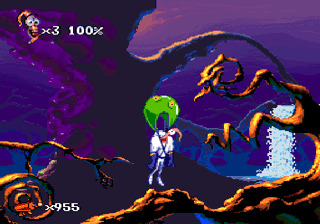 I own the Saturn version of EWJ2, so it wasn’t until recently that I got around to acquiring the Genesis cart. The differences were a lot less than I expected! The visuals aren’t as sharp, but the sound is really good compared to CD, and the gameplay is spot-on. I was only going to try out my cartridge after it arrived, and I ended up playing well over half the game before I realized I had other things to do. This is definitely a game I have to put more time into, and I will definitely be coming back to it soon. I’ve never really been a major fan of this series, but that’s due more to me not playing it as much as I should. EWJ’s humor is one that’s quite different than the typical Genesis fare, and once you warm up to it, the games are really quite charming.
I own the Saturn version of EWJ2, so it wasn’t until recently that I got around to acquiring the Genesis cart. The differences were a lot less than I expected! The visuals aren’t as sharp, but the sound is really good compared to CD, and the gameplay is spot-on. I was only going to try out my cartridge after it arrived, and I ended up playing well over half the game before I realized I had other things to do. This is definitely a game I have to put more time into, and I will definitely be coming back to it soon. I’ve never really been a major fan of this series, but that’s due more to me not playing it as much as I should. EWJ’s humor is one that’s quite different than the typical Genesis fare, and once you warm up to it, the games are really quite charming.
Sonic The Hedgehog 2 By Sebastian Sponsel
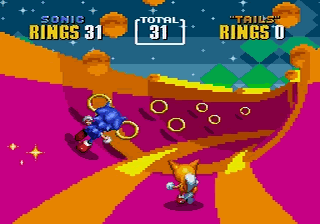 Lately me and a friend had another go at the two-player versus mode of Sonic 2. As always, we were pretty split in our opinions: I prefer the special stages in terms of competition, action, twitch-reactions and suspense when it comes to the final outcome. He, on the other hand, prefers the regular stages, as they require more skill, forethought and knowledge of the stages themselves. Naturally, he usually kicks my ass in the regular stages while I usually surpass him in the specials. We still usually enjoy the mode. However, we both agree on one thing: while it’s fun, it could definitely be better. Emerald Hill is pretty much too straightforward. Mystic Cave Zone is more versatile, but the system starts chugging when there’s too much going on onscreen; and Casino Night is too random and often too much dependent on dumb luck or misfortune when it comes to determine a winner. And there’s also the glitch regarding monitor counts. It feels like the versus mode was tacked on more as an afterthought. It’s not bad at all; it’s just lacking refinement and proper optimization. It could have been so much better…
Lately me and a friend had another go at the two-player versus mode of Sonic 2. As always, we were pretty split in our opinions: I prefer the special stages in terms of competition, action, twitch-reactions and suspense when it comes to the final outcome. He, on the other hand, prefers the regular stages, as they require more skill, forethought and knowledge of the stages themselves. Naturally, he usually kicks my ass in the regular stages while I usually surpass him in the specials. We still usually enjoy the mode. However, we both agree on one thing: while it’s fun, it could definitely be better. Emerald Hill is pretty much too straightforward. Mystic Cave Zone is more versatile, but the system starts chugging when there’s too much going on onscreen; and Casino Night is too random and often too much dependent on dumb luck or misfortune when it comes to determine a winner. And there’s also the glitch regarding monitor counts. It feels like the versus mode was tacked on more as an afterthought. It’s not bad at all; it’s just lacking refinement and proper optimization. It could have been so much better…
Still, in my opinion it’s better than the one in Sonic 3.
Shanghai II: Dragon’s Eye By David Dyne
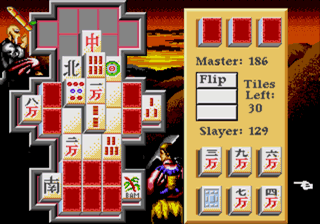 Puzzle games. These were the titles that most kids avoided buying when you could only afford one game purchase every few months. If you saw one shelf at your local Toys ‘R Us or Kaybee Toys packed with the likes of Sonic The Hedgehog, Streets of Rage, Phantasy Star 2, and Joe Montana Football while another shelf had Shove It!, Shanghai II: Dragon’s Eye, and Blockout, you’d most likely pick from the games on the first shelf and avoid the second one like the plague. I know I did. And when my subscription to Electronic Gaming Monthly or Sega Visions arrived each month I easily recall starring endlessly at the screenshots from all the major releases and glancing only briefly at the puzzle titles like they were from the housekeeping section of a Sears catalog.
Puzzle games. These were the titles that most kids avoided buying when you could only afford one game purchase every few months. If you saw one shelf at your local Toys ‘R Us or Kaybee Toys packed with the likes of Sonic The Hedgehog, Streets of Rage, Phantasy Star 2, and Joe Montana Football while another shelf had Shove It!, Shanghai II: Dragon’s Eye, and Blockout, you’d most likely pick from the games on the first shelf and avoid the second one like the plague. I know I did. And when my subscription to Electronic Gaming Monthly or Sega Visions arrived each month I easily recall starring endlessly at the screenshots from all the major releases and glancing only briefly at the puzzle titles like they were from the housekeeping section of a Sears catalog.
Shanghai first caught my attention on the Master System with its tile matching goodness and an FM chip-enhanced soundtrack. It wasn’t long before I grabbed the sequel on the Genesis which featured an additional game mode called “Dragon’s Eye.” In this game type the computer or a friend takes on the role of the Dragon Master as he tries to resurrect a dragon on the game board by placing tiles in specific areas. The opposing player is the Dragon Slayer who tries to impede and eventually thwart the Master’s plan by matching tiles to remove them from the board and blocking whenever possible. It’s quite fun and the randomized tiles keep the game fresh every time you start a new one. In the eleven matches played so far, I’ve only managed to win five of them, and yet I keep coming back night after night for another twenty minute match just to see if I can manage another victory or be completely routed. Now that I’m hopelessly addicted, I’ll be checking out Shanghai: Triple Threat on the Saturn and Shanghai Dynasty on the Dreamcast as well. Thanks Sega, you’ve opened my eyes to a genre I never gave a second look to back in the day.
Road Rash By The Coop
Back in 1991, when the Genesis was being criticized for not having the much lauded scaling and rotation ability of the SNES’ Mode 7, there were some games coming out that gave those critics the finger… sort of. Sonic The Hedgehog had rotating bonus stages, which were done with some nifty software trickery. Another game also came along that also used some neat software tricks to make objects come at the player more smoothly than the very choppy “3D” games we’d seen on the Genesis up to that point.
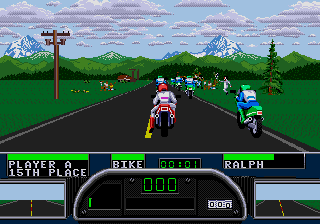 Road Rash was an interesting title idea from the get go. Riding motorcycles while punching and kicking opponents, being hit by on-coming traffic, having to run back to your bike when you got knocked off… all while trying to come in first place ahead of your rivals and avoiding traffic. It was an intriguing idea that was pulled off pretty well overall. Sure, the controls were a bit sluggish, the frame rate wasn’t superb, and the hit detection wasn’t the best, but it was fun and different. And the icing on the proverbial cake? The scaling visuals (and the great title screen song too).
Road Rash was an interesting title idea from the get go. Riding motorcycles while punching and kicking opponents, being hit by on-coming traffic, having to run back to your bike when you got knocked off… all while trying to come in first place ahead of your rivals and avoiding traffic. It was an intriguing idea that was pulled off pretty well overall. Sure, the controls were a bit sluggish, the frame rate wasn’t superb, and the hit detection wasn’t the best, but it was fun and different. And the icing on the proverbial cake? The scaling visuals (and the great title screen song too).
Trees, cars, other riders, telephone poles, houses, signs… they all came at you with a surprising level of smoothness. It wasn’t SEGA’s X and Y boards level of smooth, but it absolutely stomped on the other sprite-based stuff that was on the Genesis at the time. Seeing all those objects come at you with that level of fluidity, while going up and down hills, was a moment that made you stop playing for a few seconds so you could check it out better. It was a cool trick, and one I would have liked to have seen more games use. But that wasn’t to be the case, as the software scaling used in RR stayed in RR for the most part (save for potentially Outlander, whose graphics engine seems very similar).
So yeah, a solid game with some visual pizzazz, at a time when an object was seen as only needing about seven sprites to be considered “scaling” by some game makers. The Genesis didn’t have scaling, but with Road Rash, we saw that it could be done respectably if someone tried hard enough. And while by the end of 1991, most of SEGA’s big-name 3D arcade games had already been ported to the Genesis, it made me wonder what the likes of Super Thunder Blade, Galaxy Force II and Super Monaco GP would have looked like if they’d been given the same kind of software scaling treatment that Road Rash received. I guess like the answer to, “How many licks does it take to get to the center of a Tootsie Pop?,” the world may never know.
Virtua Racing By KitsuneNight
Originally, I wanted to talk about the 32X (the “Shroom of Doom”) and several 32X games.
Hey get back here !
Unfortunately, my 32X, has yet to arrive, so it will have to be discussed next time. However, there is a Mega Drive game that has appeared on both the stock machine and the 32X. Have a wild guess what it is. Err no, not Virtua Fighter 2.
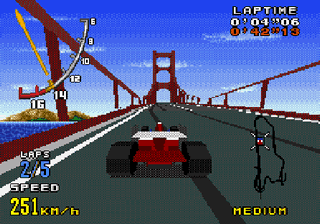 Virtua Racing, at its heart its a bare bones, low resolution, low polygonal, racer that was ported to the Mega Drive in 1994. There is nothing special about it these days: three tracks, one car, but yet it’s still a tantalizing glimpse in to what could have been if Sega had pressed on with the SVP chip, a showcase of what the Mega Drive is capable off, even with some help. It’s also impressing to see how the game is blazing along and pumping out polygons on six year-old hardware by that time. Above all, it’s mind-blowing to see a Model 1 game, no matter how cut down, run on the Mega Drive (Mega Drive II, in my case).
Virtua Racing, at its heart its a bare bones, low resolution, low polygonal, racer that was ported to the Mega Drive in 1994. There is nothing special about it these days: three tracks, one car, but yet it’s still a tantalizing glimpse in to what could have been if Sega had pressed on with the SVP chip, a showcase of what the Mega Drive is capable off, even with some help. It’s also impressing to see how the game is blazing along and pumping out polygons on six year-old hardware by that time. Above all, it’s mind-blowing to see a Model 1 game, no matter how cut down, run on the Mega Drive (Mega Drive II, in my case).
Is the 32X version better ? Probably, I’m sure I will soon find out. Is the Mega Drive version a bare bones conversion, with sparse polygonal models, that look like stick figures and make your eyes hurt, as you squint and try to make out the garbled mess of jutting polygons ? Yes. Do the cars drive like their tires are greased with butter? Yes, but it’s still amazing to see this game as it is. It’s truly a milestone in gaming and in Sega’s history. Virtua Racing begat Daytona USA, as well as Virtua Fighter and Virtua Cop and ushered in a new era of full 3D games. Other games may have been there first, but few did it as well, with so much aplomb and spectacle and that warm thrill of amazement, that Virtua Racing did.
Virtua Racing itself is a fairly shallow game, but its place is secured more for it’s technological merits, then its merits as a game but its still worth playing. I still like to drag my car around the corners of Big Forest, before crashing in to a mish-mash of polygons that vaguely resemble a wall. The game, despite its simplicity, has not failed to impress me. Cast your mind back to 1994 and see what it meant and what it could have been. And considering its cheap as chips these days, there is no reason not to own it today and not to play the hell out of it. Which is what I plan to do.
My “Shroom of Doom,” however, does come with three of the six Model 1 games ever released, but that is a subject for some other time.

The 32X version of Virtua Racing is REALLY good!!